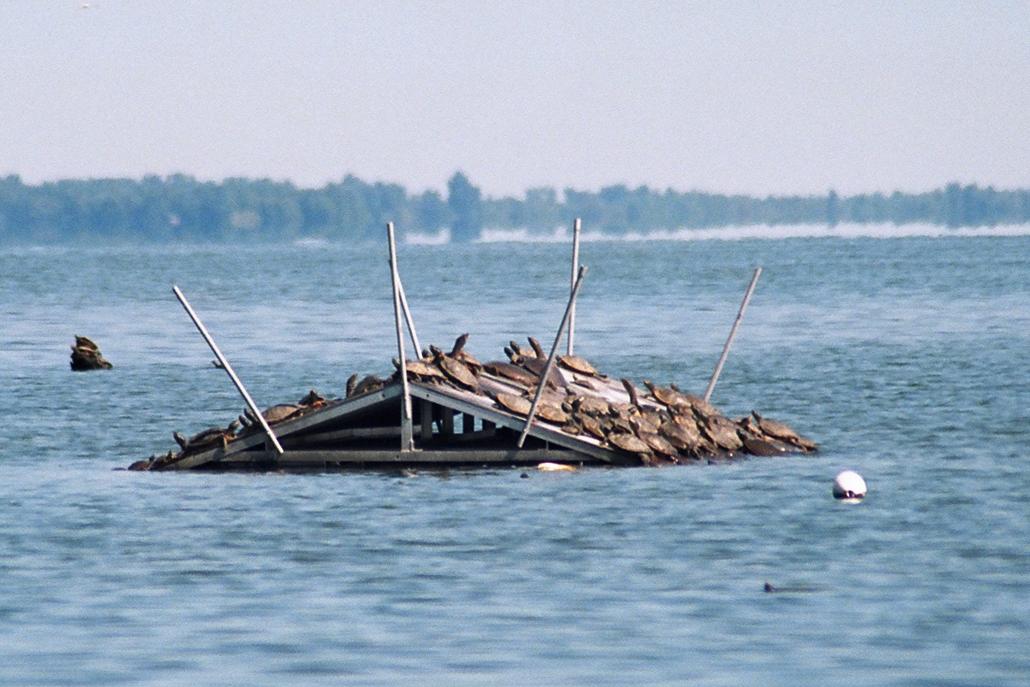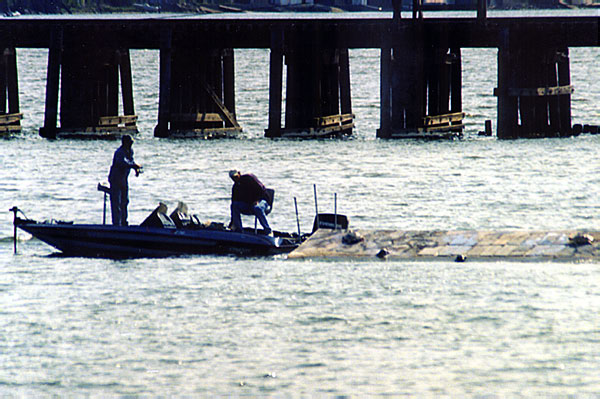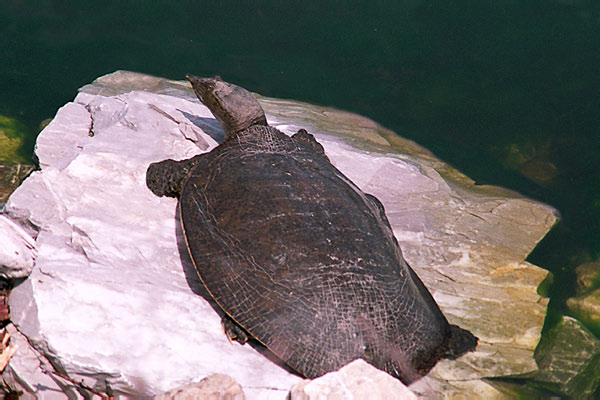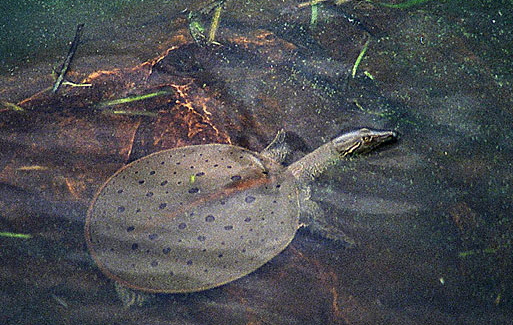|
Missisquoi Bay’s Infamous Turtles
Ron Haskell
(This article appeared in the 2004 Islands Vacation Guide)
Copyright Ron Haskell, 2004. All rights reserved
In 2003 I had an unusual opportunity come my way: Search for, identify, and photograph turtles on and around the Alburg-Swanton causeway. From April to October, I regularly trekked the length of the causeway peering over and around rocks, scanning the water, looking for turtles. Did I see any? You bet – over 2100 of the critters ranging in size from a few inches up to one-and-a-half feet long.
Actually, my assignment was a bit more complex than simply surveying the causeway. I also observed several temporary basking structures, those roof-like platforms in the bay between the causeway and rail trestle and further north near “Turtle Rock”. These platforms, built specifically for the benefit of spiny softshell turtles, are required by the Threatened and Endangered Species Taking Permit (one of many necessary to enabling the new bridge construction that began this year) issued by the Agency of Natural Resources. For much of last year's observation period, the platforms also held decoys in the hope of attracting live turtles.
To the surprise of many, the Real McCoy visited all three of the platforms several times. In fact, the northernmost platform often swarmed with both of the area's major species—spiny softshell turtles (Apalone spinifera) and map turtles (Graptemys geographica).

(On Sept. 2, 2003, the platforms definitively established their usefulness as an
alternative to basking along the causeway for both softshell and map turtles.)
Unfortunately, the two most visible platforms were often visited by another species: Homo sapiens. And that brings me to the real point of this article: Disturbing the turtles is illegal and potentially costly—illegal because softshells are a protected species, costly because of restrictions on construction activities if softshells don’t use the platforms.

(Fishermen and sightseers often got too close to the platforms, if only to see decoys,
such as these, up close or to disentangle a lure that caught on line strung to ward off birds.)
Turtles are by nature a wary lot. The oldest ones (softshells are thought to live 50-70 years) have certainly learned to survive by keeping a close eye on their surroundings. Trust me when I say that these creatures know when people are around; I've had them spot me and flee from well over 100 yards away (I've also been able to get incredibly close, but that's another story). When exposed on a platform, turtles are even more cautious. Anyone quickly approaching on foot or by boat is certain to spook a basking turtle.
We seem to think that turtles are slow and dumb. And why not, since we've been bombarded from childhood with cartoons and fables that portray them as such. In fact, a turtle in its element is alert and fast.
 
(A 16” female basks in early May (left); a 4” male basks submerged in summer.)
But people, whether on foot or in boats, seem to think they can get up close and personal with the turtles. Fishermen see the platforms and say, “Oh boy, structure; there’s a lunker bass hanging out under there.” Zing goes the cast; clunk drops the lure; and “Darn, I’m hung up on that nearly invisible line designed to keep the birds away.” Or a pedestrian resolutely marches along the causeway riprap on his way to see the turtles (okay, so he didn’t know they were decoys) on the platform, blithely unaware that with each step he’s likely disturbing a live turtle basking on the rocks below. Or a car stops on the causeway roadbed so a passenger can get out and gander (probably not a good idea when a convoy of semis is probably headed your way at 60 mph).
You get the picture.
The natural world is wonderfully soothing and inspiring, capable of easing the stress of modern life. Once the bridge is built, everyone will be able to enjoy the turtles’ natural world easily and safely since there will be a permanent basking habitat and wide shoulders for parking.
Until then, please give the platforms a wide berth and stay well back from the marker buoys. If you simply must have a closer look, use binoculars (10-20x will do) or your video camera. You’re also welcome to visit the Missisquoi Bay Bridge of this web site to see pictures from the ongoing monitoring project.
As to why this article’s title includes the word “infamous”, just ask anyone who lives or works near the causeway and I’m certain you’ll catch an earful! Of course, to many of us the turtles are simply innocuous creatures going about their simple lives. The causeway, and those who fight against its removal, is all that is truly infamous.
|

